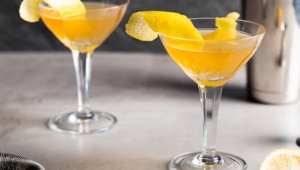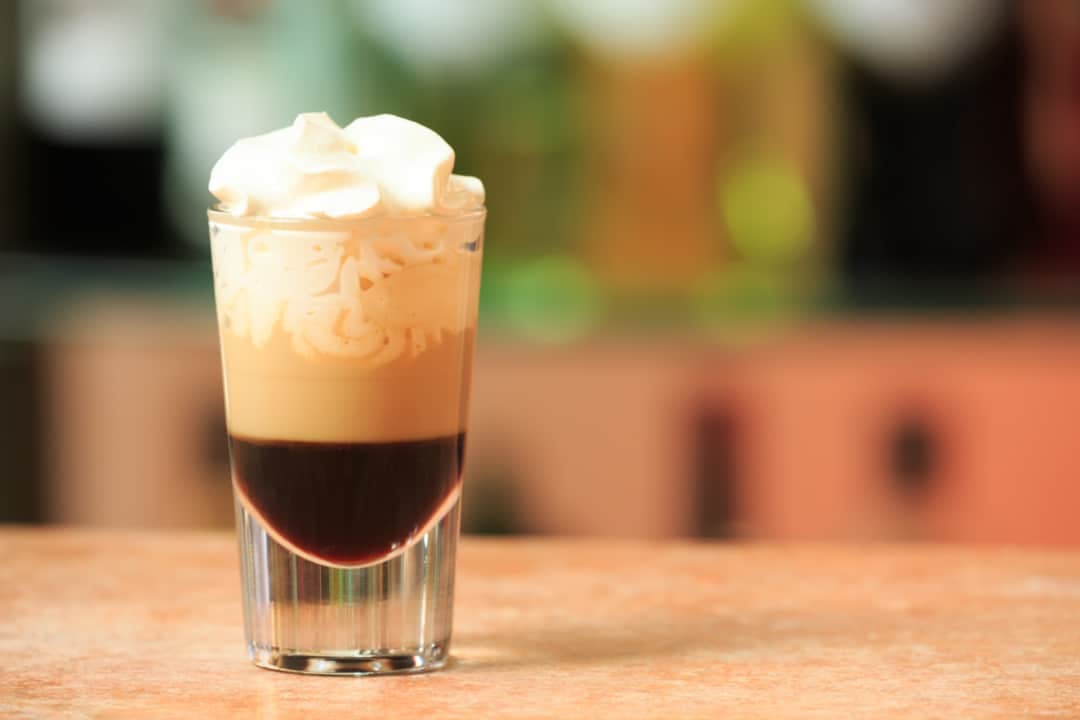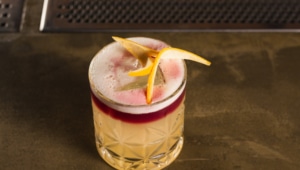Sidecar: Recipe, 5 Variations & 5 Best Cognac Brands

The Sidecar cocktail is known for being tart, sophisticated, and zesty – a true mixology classic. But what is the history of this classic cocktail, and how has it stayed popular since its inception? Let’s dig deeper and uncover the history of this citrusy classic.
Elegant, refreshing, and slightly sharp tasting, the Sidecar is the pinnacle of cocktail sophistication. With its smooth yet bold flavor palette, it is a timeless favorite – existing outside of fleeting trends.
The robust cognac combines with the sweetness of orange liqueur and the zing of lemon juice to create a perfectly harmonious beverage.
But why does this combination work so well, and what is the history of this simple yet complex drink? Read on as we explore the origins of the Sidecar, and share our secrets to crafting the perfect Sidecar at home.
Introduction to Sidecar

Introduction to Sidecar
The Sidecar evolved from the ‘sour’ family of cocktails – one of the oldest types of cocktails that have been around since the 1800s.
Known for its simplicity and elegance, the Sidecar’s classic combination of three ingredients – cognac, orange liqueur, and lemon juice – creates a delightful harmony of flavors that attracts seasoned cocktail drinkers and cocktail novices alike.
Its recipe has stood the test of time and continues to invite the creation of innovative variations.
The Sidecar is synonymous with Jazz Age elegance. It brings to mind smoky Parisian cocktail bars filled with famous intellectuals like Henry Miller and F Scott Fitzgerald.
Indeed, the drink is known to be a favorite of writer Ernest Hemingway, who is known to have called the cocktail “the only thing worth drinking”.
What Sidecar Is

What Sidecar Is
The Sidecar is a classic cocktail from the Sour family of cocktails, which includes a base liquor, lemon juice, and a sweetener.
In a Sidecar, the sweetness comes from the orange liqueur (often Cointreau or triple sec). The cohesive mix of cognac, orange liqueur, and lemon juice creates a smooth, tangy drink that is both sophisticated and easy to drink, appealing to a wide array of tastes.
Simple and classic, the Sidecar has retained its popularity for 100 years, cementing its place in the pantheon of cocktail classics.
Brief History / Origin

Brief History / Origin
As with many of the classic cocktails, the history of the Sidecar is hotly debated. Its origin can be traced to the end of World War I in Europe, with conflicting claims of whether it originated in Paris or London.
The drink is named after the one-wheeled motorcycle attachment which was very common in the 1920s.
The most reliable claimant to the Sidecar’s invention is the Ritz Hotel in Paris, although there are some suggestions the drink was invented by a bartender at Buck’s Club, in London.
Regardless of the origin, the original drink comprised equal parts of cognac, Cointreau, and lemon juice, but over time evolved to be two parts cognac and one part each of Cointreau and lemon juice.
After its popularity grew in Europe, the Sidecar was introduced to America and has remained a staple in bars across the globe ever since.
Ingredients

Ingredients
The Sidecar is simplicity itself, containing just three ingredients: cognac, orange liqueur, and lemon juice. Each of the ingredients is essential in making the cocktail the iconic drink that it is. Let’s explore what each component brings to the table:
- Cognac: The cognac provides the rich, smooth amber-colored base of this cocktail. A type of brandy from the Cognac region in France, cognac is famous for being mellow and fruity, providing a warm, smooth foundation for the drink.
- Orange liquor: Orange liqueur adds a citrusy flavor and a touch of bitterness along with its sweetness, complementing the cognac while adding complexity. The sweetness of the liqueur balances out the tartness of the lemon and adds a lightly floral, crisp flavor to the cocktail.
- Lemon juice: The lemon juice brings everything together, balancing out the sweetness of the other ingredients and creating the signature tang. The bright acidity cuts through the richness of the other ingredients, creating a vibrant, zesty drink.
Sidecars are known to be one of the more challenging drinks for bartenders to create, thanks to the necessity to precisely balance these flavors.
This is made more challenging by the fact that different orange liqueurs contain different levels of sweetness, so the ingredients often need to be adjusted to create the perfect flavor profile.
Although challenging, it’s a rewarding drink to make, with a nuanced understanding of the ingredients resulting in the ideal blend.
The drink is typically garnished with an orange twist or orange wedge, and in some versions includes a sugar rim.
Although the sugar rim is optional, it can be a delicious addition, particularly for those who prefer their cocktails on the sweet side.
With every sip, a few granules of sugar create a burst of sweetness on the tongue, perfectly complementing the relatively dry and tart beverage.
Best Cognac Brands for Sidecar

Best Cognac Brands for Sidecar
The choice of cognac can make a huge difference to the flavor profile of your Sidecar, with a wide variety in flavor and depth among brands. Choosing the right cognac can elevate your drink to new heights. As such, make sure you choose the best cognac you can afford:
- Hennessy: One of the most famous cognac brands, Hennesy is a safe choice for a Sidecar. With a rich, robust flavor and smooth, fruity notes, it adds complexity to your drink. The slight hints of oakiness and spice elevate your drink, but won’t overpower it.
- Rémy Martin: Famous for its high quality, this cognac is perfect for a luxurious, balanced sidecar. Its flavor is harmonious with notes of apricot and spice, perfectly paired with the citrusy tang of lemon juice and orange liqueur.
- Courvoisier: Courvoisier is known for its smoothness and warmth, which is ideal for a Sidecar. This cognac has fruity, floral notes and the slightest hint of vanilla – perfect to add complexity to your drink
- Martell: For a truly unique and complex cocktail, we love Martell. With hints of crystalized fruit, plum, and licorice, it’s fruity, sweet silky, and fantastically smooth.
- Hine: Hine cognac has a more peppery and oaky flavor than the other cognacs, which we think pairs perfectly with the citrus flavors of a Sidecar. With notes of honeyed nuts, berries, and cinnamon, it adds complexity and nuance to your cocktail experience.
Best Orange Liqueurs for Sidecar

Best Orange Liqueurs for Sidecar
Choosing the right orange liqueur is essential when creating a harmonious sidecar. Different liqueurs have different flavor profiles and sweetness levels. This can affect the overall flavor of the drink:
- Cointreau: the most popular choice for Sidecars, Cointreau is famous for its clean, crisp orange flavor. It blends perfectly with cognac, enhancing the overall flavor of the cocktail.
- Grand Marnier: Grand Marnier blends cognac with bitter orange essence, and is the perfect choice for creating a luxurious Sidecar with added depth. It has a heavier flavor than Cointreau, adding sophistication and nuance.
- Triple Sec: The general name for a class of orange liqueurs, Triple Sec is often lighter in alcohol compared to other orange liqueurs and has a simpler orange flavor. We like this for a lighter, more simplistic sidecar, or those with a sweeter tooth.
Recipe – How to Make a Sidecar

Recipe – How to Make a Sidecar
Creating the perfect Sidecar means balancing the zesty, sweet, and rich flavors to create a harmonious cocktail. Thanks to its elegance and simplicity, the Sidecar has remained a favorite, with its simple recipe of just three ingredients.
Once you’ve mastered the authentic Sidecar recipe, you can experiment and add your twists to the classic formula.
Gather your ingredients – you’ll need:
- 2 parts cognac of your choice
- 1 part orange liqueur of your choice (such as Cointreau or Grand Marnier)
- 1 part fresh lemon juice
- Ice Cubes
- Orange twist
- Optional – fine sugar for the rim.
Collect your tools – you’ll need:
- Cocktail shaker
- Strainer
- Measure
- Martini glass or coupe glass.
And here’s how you do it:
- Prepare your cocktail. If you’re choosing to sugar your rim, run a lemon wedge around the rim of your glass and then dip it into the fine sugar and set it aside.
- Add ice and measure out cognac, orange liqueur, and lemon juice to the cocktail shaker. Shake it vigorously until the cocktail is well chilled, about 20 seconds.
- Strain the cocktail into your prepared glass and garnish with an orange twist. Serve immediately.
Time & Occasions for Drinking a Sidecar

Time & Occasions for Drinking a Sidecar
The Sidecar is one of the most versatile cocktails around and is well-suited for drinking at any time of day or any occasion.
Most traditionally, the sidecar is enjoyed before dinner as an aperitif, because its crisp dry flavor makes it the perfect palate cleanser. The refreshing, zingy tartness and mild sweetness stimulate the appetite, making it a great choice for pre-dinner drinks.
Sidecars are classic and elegant, sophisticated and sleekly modern, making them perfect for formal affairs and black-tie events.
We love Sidecars at cocktail parties or formal dinner gatherings, with its timeless appeal adding charm and a sense of occasion.
For those who prefer a more casual setting, the Sidecar is also perfect for drinking at home or your local bar. It can even be a sophisticated addition to an adventurous brunch menu.
The limit is your imagination. And although most cocktails are enjoyed before a meal, the Sidecar is simple and versatile enough to drink alongside your meal. Just make sure you choose proper flavors that complement it.
The Sidecar can be enjoyed in all seasons. The citrusy flavors and icy coolness pair well with hot summer nights, while the warmth of the brandy makes it ideal to sip by a roaring fire.
A Sidecar is equally at home in a cozy cocktail bar on a cold winter night as it is under the sun at a lively garden party. It truly is the most perfect cocktail for all occasions.
Perfect Pairings

Perfect Pairings
Sidecar cocktails have a complex flavor profile that pairs well with many foods. The key to success is to pick foods that complement the sweet and tart flavors of a classic sidecar. From cheeses and cured meats to seafood, there are many culinary delights that can partner with the Sidecar:
- Soft cheeses: The rich, creamy texture of soft cheeses such as Brie and Camembert perfectly complements the crisp acidity and mild sweetness of a sidecar. The oaky, earthy notes of the cognac also pair well with the rich texture of the cheese.
- Salmon: The acidity of the Sidecar makes it the perfect pairing for the rich, oily, salty flavors of salmon. The citrus notes pair perfectly with the salmon’s rich flavors, particularly smoked salmon.
- Cured meats: Cured meats and charcuterie are ideally paired with Sidecars, as they create the perfect pairing of salty and slightly sweet. Prosciutto in particular works well with the Sidecar’s citrusy, boozy notes, creating the perfect counterpoint.
- Herb stuffed mushrooms: The earthy flavors of mushrooms, the botanical bouquet of herbs, and the zingy, oaky flavors of the Sidecar – it’s a match made in heaven! The citrus notes of the orange liqueur bring brightness and zing to the savory mushrooms, creating the perfect blend of flavors.
- Spicy shrimp: The spicy flavors of the shrimp can be mellowed by the slightly sweet and tangy taste of a Sidecar. The citrus notes are also perfect with all types of seafood, complementing the delicate, briny flavors.
- Bruschetta: A classic bruschetta served with tomato, basil, and olive oil is the ideal palate cleanser. The lemony, zesty flavors of the Sidecar bring out the umami flavors of the bruschetta, harmonizing to create the perfect bite.
- Apple strudel: Hear us out – a Sidecar can be an excellent dessert pairing. The warm, flaky apple strudel combined with the rich, zingy, citrusy Sidecar – it’s the perfect combination.
Best Glass to Serve a Sidecar

Best Glass to Serve a Sidecar
The best glass to service your Sidecar in is a coupe glass or martini glass. The coupe glass has a broad, shallow bowl and an elegant stem, creating an aesthetically pleasing and functional cocktail.
The wide rim of a coupe glass is perfect for the optional sugared rim and also allows for easy sipping. The wide, open bowl lets the citrusy and fruity aromas of the cocktail be easily smelled, which enhances the overall sensory experience.
It’s essential that your Sidecar is enjoyed ice cold, and the coupe glass is perfect for this, as it ensures that warmth isn’t transferred from your hand to the cocktail.
Variations of Sidecar

Variations of Sidecar
The classic Sidecar has inspired a huge range of variations and twists on the original trio of cognac, orange liqueur, and lemon juice.
Twists on the sidecar exist to cater to a range of tastes, while still keeping the essence of the original Sidecar intact.
With variations ranging from substituting the base spirit to adding extra ingredients, there is no end to the ways this cocktail can be enjoyed. Here are some of the most popular variations.
White Lady

White Lady
The White Lady retains the essence of the classic Sidecar, but swaps out cognac for gin, creating a clear color palette and adding herbal, botanic notes. They often also include egg white for a frothy appearance.
Chelsea Sidecar

Chelsea Sidecar
A more simplistic version of the White Lady cocktail, the Chelsea Sidecar replaced cognac with gin and used a simple sugar syrup to create a citrusy, zesty treat.
Thanks to the inclusion of gin and the addition of sweetener, this cocktail has a lighter, more floral flavor than a traditional Sidecar, making it perfect for a hot summer evening.
Bourbon Sidecar

Bourbon Sidecar
As the name suggests, this twist on the original replaces the cognac with bourbon. The drink is smokier, richer, and has more depth of flavor, ideal for those who prefer whisky-based cocktails.
New York Sour

New York Sour
Although not a direct variant of a Sidecar, the New York Sour is from the same family of cocktails and has a similar citrusy flavor profile. It mixes whisky, lemon juice, and red wine for a zingy, smoky-sweet, and fruity cocktail.
Daisies (e.g., Whiskey Daisy, Gin Daisy)

Daisies (e.g., Whiskey Daisy, Gin Daisy)
The Daisy family of cocktails are close relatives of the sidecar. They usually combine citrus, a spirit, and a syrupy sweetener, creating a drink with a similar flavor profile to a Sidecar but usually a little sweeter.
Similar Cocktails You Will Enjoy

Similar Cocktails You Will Enjoy
If you enjoy Sidecars, we think you’ll enjoy these cocktails with a similar flavor profile. They all share an element of what makes the Sidecar so special. This ranges from the citrusy profile, the cognac base, and the sour flavor.
Cognac Sour

Cognac Sour
If you’re a cognac lover, the Cognac Sour is a must-try. It has the same lemony tartness and brandy base but adds a sweetener and egg white for a frothy, silky texture.
Vieux Carré

Vieux Carré
This classy cocktail, the Vieux Carré, hails from New Orleans, and blends cognac with whiskey, sweet vermouth, Benedictine, and bitters. This drink is complex, robust, and extremely strong – perfect for those who like their cocktails to pack a punch.
French 75

French 75
For citrus lovers, the French 75 is ideal. It combines gn with lemon juice, simple syrup, and champagne, for a light, zesty, and refreshing drink.
Corpse Reviver No. 2

Corpse Reviver No. 2
Another citrus-heavy drink, the Corpse Reviver mixes gin with Lillet Blanc, orange liquor, and lemon juice, with a dash of absinthe. It’s complex and highly aromatic – perfect for a sophisticated palate.
Between the Sheets

Between the Sheets
This twist on the Sidecar combines the classic trio of cognac, Cointreau, and lemon juice with rum, creating a multi-dimensional beverage. The rum adds a touch of sweetness and extra depth while maintaining the classic elegance of the Sidecar.
- Rum Runner. Tasty Recipe + Variations.
- Gin Rickey. Best Brands + Similar Cocktails.
- Manhattan. Recipe, Tips and Variations.
- Dirty Martini. Best Recipes and Similar Cocktails.
- Moscow Mule. Facts, Ingredients and a Recipe.
- Hibiscus Tea. Health Benefits and Recipe.





